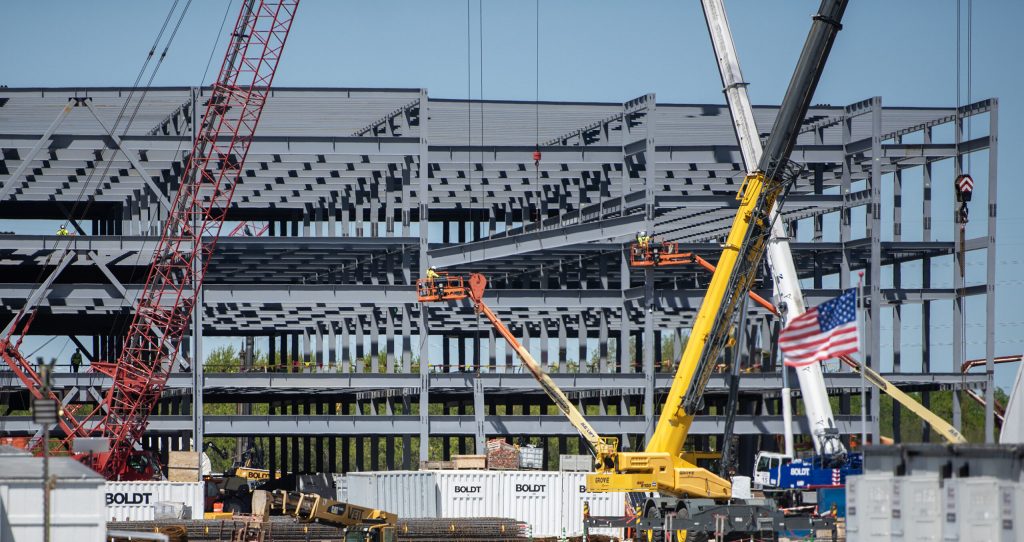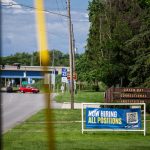Large Data Center Planned for Ozaukee County
Proposal for an unidentified tenant requires annexation of more than 1,000 acres of land.

An artificial intelligence data center is built on land once slated for development by Foxconn in Mount Pleasant on Wednesday, May 8, 2024, in Mount Pleasant, Wis. Angela Major/WPR
Southeast Wisconsin might soon be home to another data center — this time in Port Washington.
Cloverleaf Infrastructure, a Houston- and Seattle-based developer, is working with the City of Port Washington to put a data center on over 1,000 acres of farmland north of the city. That land was previously in the sights of a microchip maker, but that project did not move forward.
Cloverleaf Chief Development Officer Aaron Bilyeu came to Port Washington Tuesday night to speak to the city’s Common Council.
He said his company prepares sites for data center construction by buying up property, connecting it to the power grid and selling it on to a client like Google or Apple.
“As I like to say — and certain people like to make fun of me for — it’s quiet, dark rooms and servers going blinky-blinky all day,” Bilyeu said.
He said most data centers employ between 50 and 100 people in office jobs.
“The only time people go into those server halls is when you get a hard drive failure or something like that,” he said.
He said he couldn’t give a specific acreage or wattage for the data center yet. But he said many modern data centers require 350 megawatts. That’s enough to power 280,000 households.
The entire city of Milwaukee has 231,000 households.
A Microsoft data center campus now under construction in Mt. Pleasant is expected to use 450 megawatts of power when complete, according to a company spokesperson.
Artificial intelligence drives the growing energy needs of data centers. NPR reported in July that the power needs of AI tools have increased Google’s greenhouse gas emissions by 50 percent over the last five years, and that asking AI chatbot ChatGPT one question is equivalent to burning a lightbulb for 20 minutes.
Mayor supports project
At the Common Council meeting, Port Washington mayor Ted Neitzke IV said that the potential data center’s advantages “far outweigh the cons” for his city.
He said the loss of local manufacturers — like the lawnmower-maker Simplicity — have made the city’s revenue too dependent on residential property taxes. He said restoring a “greater developmental mix” would shift the tax burden back to commercial landowners.
Neitzke told the Ozaukee Press that the city would consider creating a tax-increment financing district to pay for sewer and water extensions to the data center.
Development would require annexation
There is one more player in the development story: the Town of Port Washington.
The potential construction area — between I-43, Dixie Road and the Ozaukee Interurban Trail — and its current landowners are within the town’s borders.
Development would require annexation by the city, which can’t happen until the municipalities’ current land agreement expires in December 2025, or both parties agree to cancel it early.
At its meeting on Monday, the town board delayed taking any action on the border agreement, TMJ4 reported.
Chair Mike Didier did not respond to a WPR request for comment on Thursday.
Bilyeu said many landowners within the potential site are already under contract for a sale.
“We have a few that we’re still having conversations with,” he said.
If the data center is built, it would join a proposed center in Kenosha County as well as Microsoft’s planned data center campus in Mount Pleasant. Construction on a portion of the Microsoft project is underway, but the company recently announced it was pausing work on another phase of the development.
Large data center may be coming to Port Washington was originally published by Wisconsin Public Radio.
If you think stories like this are important, become a member of Urban Milwaukee and help support real, independent journalism. Plus you get some cool added benefits.






















Why is the eventual tenant a secret? We don’t need another Foxconn con. Land grabs that force people out of their homes should at least be transparent…
That’s a ludicrous amount of power needed to support the array of equipment for today’s artificial intelligence endeavors. Who wants to pay that kind of electric bill? As this Port Washington deal is being put together, there are initiatives out there to bring AI cost and power numbers way, way down.
I question the long-term necessity for such a large, expensive building to support soon-to-be old technology. What does the community do with this enormous structure after it’s no longer needed?
Commish: “What does the community do with this enormous structure after it’s no longer needed?”
Possibly the same thing they’re doing with the Milwaukee Public Museum, Wisconsin State Office Building, etc.
Deferred maintenance eventually makes them too costly to repair or renovate.
It seems that Cloverleaf is a developer and the article says its business involves buying property and connecting it to the grid so that it can sell it to a co pant that wants to build a data center. So, it may well not know the end-buyer. Or, maybe it does or at least as a sense of who might be interested. Either way, I don’t think Cloverleaf or any developer is required to disclose that.
Earlier in 2024, Cushman & Wakefield was up there buying up land for a client who was rumored to want to put a chip manufacturing facility up there.
https://www.ozaukeepress.com/content/microchip-deal-broker-courting-other-buyers
NDAs were sighed by the mayor and town council and a lot of property was purchased, but then the plan was dropped. So, this new development is clearly the result of that. It’s sounds like a lot of peeps in Port Washington didn’t want a chip manufacturing facility, maybe because they want to maintain a certain way of life. All I know is that given the choice, I would much rather have a major manufacturer in my town providing hundreds of good paying jobs than have a data center taking up lots of space and oodles of energy for something like 50-80 jobs.
I wonder how much more of this SE Wisconsin will see in the coming years, and what its impact will be. The region needs thousands on jobs at all levels to ensure the region thrives and is competitive. It needs companies who want to invest in the area not simply because of its natural resources, but because of our broad and deep talent pool. Unfortunately, I don’t think that breadth or depth exists in SE Wisconsin, at least not a the numbers required. I’m sure schools like MATC and Gateway Technical College are stepping up. I know GTC was trying to work with Foxconn to ensure it had the workforce it needed. We see how that worked out…
If Port Washington agrees to annex and extend utilities, they better get a financial guarantee that the company will complete their project to cover the costs and ongoing maintenance of those utility extensions. Otherwise they’ll end up like Racine who paid for all the utility extensions to Mount Pleasant/Foxconn and then got stuck with the bill.
To provide some context into the national/global need for data centers for AI, here’s a bit of what Ezra Klein wrote about recently in The NY Times:
https://www.nytimes.com/2025/01/12/opinion/ai-climate-change-low-birth-rates.html?smid=nytcore-ios-share&referringSource=articleShare
We may not understand much that these A.I. models do, but we know what they need: chips and training data and energy. The first wave of A.I., Jack Clark, a co-founder of Anthropic and a former policy director at OpenAI, writes, was about algorithmic dominance: “Did you have the ability to have enough smart people to help you train neural nets in clever ways?” Then came the need for computing dominance: “Did you have enough computers to do large-scale projects?” But the future, he says, will turn on power dominance: “Do you have access to enough electricity to power the data centers?”
A report from the Lawrence Berkeley National Laboratory estimates that U.S. data centers went from 1.9 percent of total electrical consumption in 2018 to 4.4 percent in 2023 and will consume 6.7 percent to 12 percent in 2028. Microsoft alone intends to spend $80 billion on A.I. data centers this year. This elephantine increase in the energy that will be needed not just by the United States but by every country seeking to deploy serious A.I. capabilities comes as the world is slipping further behind its climate goals and warming seems to be outpacing even our models.
So if I read this correctly, the boundaries are:
I-43 on the west
Dixie Highway on the north
Highway LL on the east
If that is correct what is the southern boundary?
@kaygeeret – I believe I-43 is the eastern boundary, the western boundary is the Ozaukee Interurban Trail, the northern boundary is Dixie Road, so the southern boundary is either Lake Drive or possibly I-43 again as the highway swings to the southwest and crosses the Interurban Trail on the northern edge of the city of Port Washington.
Important also to estimate water demand and impacts re: cooling and power.
Fabulous. I can’t wait to subsidize this place through my WE Energies bills. Heck, they’ll probably have to build another coal plant just to power this.
Thank you, Alan Bartelme. I haven’t been up there in awhile and was clearly off base.
I am sure they figure “no problem” for the water. After all Lake Michigan is right there!!!!
Add that to all the western states planning on building pipelines to take water from the Great Lakes and we will be water free in the future.
My last sentence is not a joke. Both Arizona and Nevada have publicly discussed this as a solution to their water problems.
Kaygeeret: The Great Lakes-St. Lawrence River Basin Water Resources Compact was approved by all eight Great Lakes states and the U.S. Congress, and I believe Canda and the bordering provinces. (Not 100% sure about Canada.) President George W. Bush signed the Compact into law in 2008. This prohibits the states outside of the Pact from acquiring water.